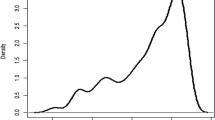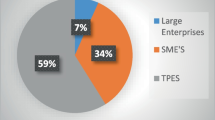Abstract
This paper compares the technical efficiency of small and medium-sized enterprises (SMEs) with that of large firms and studies the factors influencing technical efficiency for Taiwan’s electronics industry. Unlike conventional studies, we use two alternative approaches to control for the influence of size effect. One is the two-stage switching regression to correct for endogenous size effect on technical efficiency and, the other is, a metafrontier production function for firms in different groups. The main results are as follows. First, the average technical efficiency for large firms is higher than that of SMEs, without considering the size effect, and lower when considering the endogenous choice on firm size. This study cannot, therefore, conclude that there is a negative size–technical efficiency relationship. It however, sheds light on the importance of size effect on the size–technical efficiency nexus. Second, the estimates on the determinants of technical efficiency show that being a subcontractor has a statistically significant positive influence on SMEs’ technical efficiency, but the effect decreases with firm size.
Similar content being viewed by others
Notes
For a study on the role of SMEs in economic development and growth, please refer to Acs (1992). On the basis of both economics and welfare, You (1995) argued that an expansion of the small-firm segment leads to more efficient resource allocation, less unequal income distribution, and less underemployment, because small firms tend to use more labor-intensive technologies.
The concepts of efficiency, allocative efficiency, and technical efficiency, please refer to Kumbhakar and Lovell (2000).
X-efficiency is the effectiveness with which a given set of inputs are used to produce outputs. If a firm is producing the maximum output it can, given the resources it employs and the best technology available, it is said to be x-efficient. Therefore, X-inefficiency occurs when X-efficiency is not achieved. The concept of X-efficiency was introduced by Leibenstein (1966).
For the linkage between factor demand and a firm’s technology and factor price, see Little et al. (1987) for an extensive discussion.
As for the pre-1990 studies, please refer to Lundvall and Battese (2000) for a comprehensive review.
A large body of related literature defines this behavior as “outsourcing.” We prefer to adopt the term “subcontracting” in this article, because the term is traditionally used in many of the Asian countries.
For the calculation of technical efficiency in the stochastic frontier production function, please refer to Jondrow et al. (1982).
There is also a two-stage approach using the technique of the Tobit model as the second-step to investigate the determinants of technical efficiency. However, recent research has shown how inappropriate the two-step framework is and suggests that the single-stage estimation procedure is more appropriate (Wang and Schmidt 2002; Greene 2005; Simar and Wilson 2007).
Due to the null values of inputs or output, 246 observations are dropped from our empirical work.
The value of the generalized likelihood-ratio (LR) statistic not displayed in this article shows that the Cobb–Douglas technology is rejected, meaning that input and substitution elasticities are not constant among firms.
Refer to Battese et al. (2004) for more details.
The LR statistic is defined by \(\lambda=-2\ \{\ln[\hbox{H}_{0}/\hbox{H}_{1}]\}= -2\ \{\ln[(\hbox{H}_{0})]-\ln[(\hbox{H}_{1})]\},\) where \(\ln[(\hbox{H}_{0})]\) is the value of the log likelihood function for the stochastic frontier estimated by pooling the data for LEs and SMEs and \(\ln[(\hbox{H}_{1})]\) is the sum of the values of the likelihood functions for production frontiers of LEs and SMEs.
References
Abraham, K. G., & Taylor, S. K. (1996). Firms’ use of outside contractors: Theory and evidence. Journal of Labor Economics, 14, 394–424.
Acs, Z. J. (1992). Small business economics: A global perspective. Challenge, 35(6), 38–44.
Aigner, D. J., Lovell, C. A. K., & Schmidt, P. (1977). Formulation and estimation of stochastic frontier function models. Journal of Econometrics, 6, 21–37.
Alvarez, R., & Crespi, G. (2003). Determinants of technical efficiency in small firms. Small Business Economics, 20, 233–244.
Aw, B. Y., & Batra, G. (1998). Technological capability and firm efficiency in Taiwan. World Bank Economic Review, 12(1), 59–79.
Aw, B. Y., & Huang, A. R. (1995). Productivity and the export market: A firm-level analysis. Journal of Development Economics, 47(2), 313–332.
Aw, B. Y., Chen, X., & Roberts, M. J. (2001). Firm-level evidence on productivity differentials and turnover in Taiwanese manufacturing. Journal of Development Economics, 66, 51–86.
Battese, G. E., & Coelli, T. J. (1995). A model for technical inefficiency effects in a stochastic frontier production function for panel data. Empirical Economics, 20, 325–332.
Battese, G. E., & Rao, D. S. P. (2002). Technology gap, efficiency and a stochastic metafrontier function. International Journal of Business and Economics, 1(2), 1–7.
Battese, G. E., Rao, D. S. P., & O’Donnell, C. J. (2004). A metafrontier production function for estimation of technical efficiencies and technology gaps for firms operation under different technologies. Journal of Productivity Analysis, 21, 91–103.
Berry, A., & Mazumdar, D. (1991). Small-scale industry in the Asian-Pacific region. Asian-Pacific Economic Literature, 5, 35–67.
Biggs, T., Shah, M., & Srivastava, P. (1996). Technological capabilities and learning in African enterprises. Case studies series. Washington: Regional Program of Enterprise Development (RPEP), World Bank.
Brada J. C., King, A. E., & Ma, C. Y. (1997). Industrial economics of transition: Determinants of enterprise efficiency in Czechoslovakia and Hungary. Oxford Economic Paper, 49, 104–127.
Bunch, D., & Smiley, R. (1992). Who deters entry? Evidence on the use of strategic entry deterrents. Review of Economics and Statistics, 79, 509–521.
Cabral, L. M. B., & Mata, J. (2003). On the evolution of the firm size distribution: Facts and theory. American Economic Review, 93, 1075–1090.
Coelli, T. J. (1996). A Guide to FRONTIER Version 4.1: A computer program for frontier production function estimation. CEPA Working Paper 97/07, Department of Econometrics, University of New England, Australia.
Fixler, D., & Siegel, D. (1999). Outsourcing and productivity growth in services. Structural Change and Economic Dynamic, 10, 177–194.
Garen, J. E. (1984). The returns to schooling: A selectivity bias approach with a continuous choice variable. Econometrica, 25, 1199–1218.
Geroski, P. A. (1995). What do we know about entry? International Journal of Industrial Organization, 13, 421–440.
Glass, A. J., & Saggi, K. (2001). Innovation and wage effects of international outsourcing. European Economic Review, 45(1), 67–86.
Greene, W. (2002). Alternative panel data estimators for stochastic frontier models. Working Paper, Department of Economics, Stern School of Business, NYU.
Greene, W. (2005). Reconsidering heterogeneity in panel data estimators of the stochastic frontier model. Journal of Econometrics, 126(2), 269–303.
Haddad, M., & Harrison, A. (1993). Are there positive spillovers from foreign direct investment? Evidence from panel data for Morocco. Journal of Development Economics, 42, 51–74.
Hayami, Y. (1969). Sources of agricultural productivity gap among selected countries. American Journal of Agricultural Economics, 51, 564–575.
Heckman, J. J. (1979). Sample selection bias as a specification error. Econometrica, 47, 153–161.
Heshmati, A. (2003). Productivity growth, efficiency and outsourcing in manufacturing and service industries. Journal of Economic Surveys, 17, 79–112.
Hill, H., & Kalirajan, K. P. (1993). Small enterprise and firm-level technical efficiency in the Indonesian garment industry. Applied Economics, 25(9), 1137–1144.
Hu, M. W., & Schive, C. (1997). A study on the productivity and efficiency of SMEs in Taiwan manufacturers. Taiwan Economic Review, 25(1), 1–26.
Jondrow, J., Lovell, C. A. K., Materov, I. S., & Schmidt, P. (1982). On the estimation of technical inefficiency in the stochastic frontier production function model. Journal of Econometrics, 19, 233–238.
Jovanovic, B. (1982). Selection and the evolution of industries. Econometrica, 50(3), 649–670.
Kimura, F. (2002). Subcontracting and the performance of small and medium firms in Japan. Small Business Economics, 18, 163–175.
Kitching, G. (1982). Development and underdevelopment in historical perspective. London: Metheun.
Kumbhakar, S. C., & Lovell, C. A. K. (2000). Stochastic frontier analysis. Cambridge: Cambridge University Press.
Kumbhakar, S. C., & Tsionas, E. G. (2006). Does deregulation change economic behavior of firms? A latent class approach. Working Paper, Department of Economics, University of Crete.
Lau, L. J., & Yotopoulos, P. A. (1989). The meta-production function approach to technological change in world agriculture. Journal of Development Economics, 31, 241–269.
Leibenstein, H. (1966). Allocative efficiency versus X-efficiency. American Economic Review, 56(3), 392–415.
Little, I. M. D., Mazumdar, D., & Page, J. M. Jr. (1987). Small manufacturing enterprises: A comparative analysis of Indian and other economies. Washington: Oxford University Press.
Lundvall, K., & Battese, G. E. (2000). Firm size, age and efficiency: Evidence from kenyan manufacturing firms. Journal of Development Studies, 36, 146–163.
Marsili, O. (2002). Technological regimes and source of entrepreneurship. Small Business Economics, 19, 217–231.
Orea, L., & Kumbhakar, S. C. (2003). Efficiency measurement using a stochastic frontier latent class model. State University of New York at Binghamton, mimeo.
Pack, H. (1982). Aggregate implications of factor substitution in industrial processes. Journal of Development Economics, 11, 1–38.
Roberts, M. J., & Tybout, J. R. (1996). Industrial evolution in developing countries: Micro patterns of turnover, productivity and market structure. Oxford: Oxford University Press
Sharma, K. R., & Leung, P. S. (2000). Technical efficiency of carp production in India: A stochastic frontier production function analysis. Aquaculture Research, 31, 937–947.
Simar, L., & Wilson, P. W. (2007). Estimation and inference in two-stage, semi-parametric models of production processes. Journal of Econometrics, 136(1), 31–64.
Soderbom, M., & Teal, F. (2004). Size and efficiency in African manufacturing firms: Evidence from firm-level panel data. Journal of Development Economics, 73, 369–394.
Taylor, C. R., & Wiggins, S. N. (1997). Competition or compensation: Supplier incentives under the American and Japanese subcontracting systems. American Economic Review, 87(4), 598–618.
Taymaz, E. (2005). Are small firms really less productive? Small Business Economics, 25, 429–445.
Taymaz, E., & Saatci, G. (1997). Technical change and efficiency in Turkish manufacturing industries. Journal of Productivity Analysis, 8, 461–475.
Wang, H. J., & Schmidt, P. (2002). One-step and two-step estimation of the effects of exogenous variables on technical efficient levels. Journal of Productivity Analysis, 18, 129–144.
Yang, C. H. (2003). Exporting and productivity—a firm-level analysis of the Taiwan electronics industry. Developing Economies, 41(3), 340–361.
You, J. I. (1995). Small firms in economic theory. Cambridge Journal of Economics, 19(3), 441–462.
Acknowledgments
We thank anonymous referees and the Editor for their helpful suggestions and Chia-Hui Huang for excellent research assistant.
Author information
Authors and Affiliations
Corresponding author
Rights and permissions
About this article
Cite this article
Yang, CH., Chen, KH. Are small firms less efficient?. Small Bus Econ 32, 375–395 (2009). https://doi.org/10.1007/s11187-007-9082-x
Received:
Accepted:
Published:
Issue Date:
DOI: https://doi.org/10.1007/s11187-007-9082-x




